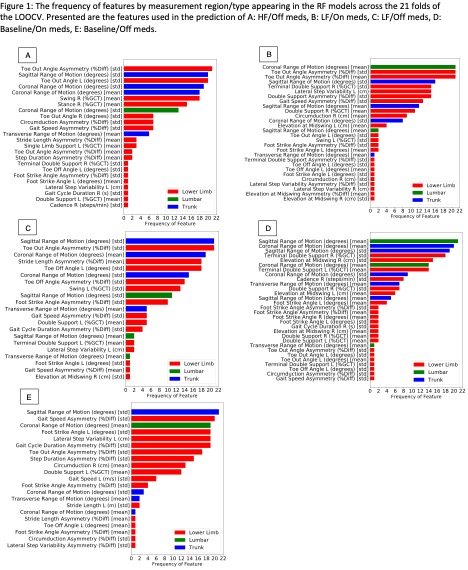Category: Surgical Therapy: Parkinson's Disease
Objective: This study investigates whether gait features derived from an instrumented walk can predict specific treatment conditions (stimulation frequency and medication status) in a cohort of chronic Subthalamic Nucleus (STN)-Deep Brain Stimulation (DBS) Parkinson’s patients using machine-learning.
Background: High frequency (HF) (180 Hz) STN-DBS is an effective therapy for advanced PD patients with medication-induced motor complications [1, 2]. Studies have suggested that low frequency (LF) (60 Hz) DBS may have therapeutic benefits for gait disorder in some chronic DBS patients [3]. However, predicting which patients could respond to HF or LF remains unclear.
Method: This study analyzed the spatial-temporal gait features of 21 STN-DBS patients (16Male, 5 female, mean disease duration 13.5 years) through instrumented SAW trials. Each SAW trial consists of a standing period, followed by a 7-meter walk, a 180-degree turn, and a 7-meter walk back. These trials were conducted under six treatment conditions (HF/On meds, LF/On meds, HF/Off meds, LF/Off meds, Baseline/On meds, Baseline/Off meds); “Baseline” refers to absence of DBS stimulation, while levodopa was used for the On Med state. Each patient made approximately eight walks under HF and LF stimulation and two walks under Baseline conditions. Separate random forest (RF) classifiers [4] were trained to identify patients’ treatment conditions corresponding to SAW trials. These models were evaluated using leave-one-out cross-validation (LOOCV), wherein each fold, one patient is left out of training and used for testing. Data were balanced via resampling to address the disparity of trials among conditions. Parameter pruning based on the Gini measure of node impurities [5] was performed to identify each model’s top ten most important features.
Results: The mean and 95% confidence interval (CI) for performance metrics are presented for each model in Table 1. Each model’s performance is compared against HF/On meds, which was defined as the standard of care. The frequency of models’ features is presented in Figure 1.
Conclusion: These results indicate that machine-learning could identify treatment conditions within chronic DBS patients based on gait measures. Lower-limb, trunk, and lumbar features discriminated these conditions with classification of medicated conditions having the greatest predictive performance.
References: [1] M. C. Rodriguez‐Oroz, E. Moro, and P. Krack, “Long‐term outcomes of surgical therapies for Parkinson’s disease,” Mov Disord, 2012; 27: 1718-1728.
[2] Castrioto A, Lozano AM, Poon YY, Lang AE, Fallis M, Moro E. Ten-year outcome of subthalamic stimulation in Parkinson disease: a blinded evaluation. Arch Neurol 2011;68:1550-1556.
[3] Khoo HM, Kishima H, Hosomi K, et al. Low-frequency subthalamic nucleus stimulation in Parkinson’s disease: a randomized clinical trial. Mov Disord 2014;29:270-274
[4] L. Breiman, “Random forests,” Machine learning, vol. 45, no. 1, pp. 5-32, 2001.
[5] P.-N. Tan, M. Steinbach, and V. Kumar, Introduction to data mining. Pearson Education India, 2016.
To cite this abstract in AMA style:
J. Watts, A. Khojandi, R. Ramdhani. Machine Learning and Instrumented Gait Analysis to Classify Subthalamic DBS States in Parkinson’s Disease [abstract]. Mov Disord. 2022; 37 (suppl 2). https://www.mdsabstracts.org/abstract/machine-learning-and-instrumented-gait-analysis-to-classify-subthalamic-dbs-states-in-parkinsons-disease/. Accessed December 20, 2025.« Back to 2022 International Congress
MDS Abstracts - https://www.mdsabstracts.org/abstract/machine-learning-and-instrumented-gait-analysis-to-classify-subthalamic-dbs-states-in-parkinsons-disease/


